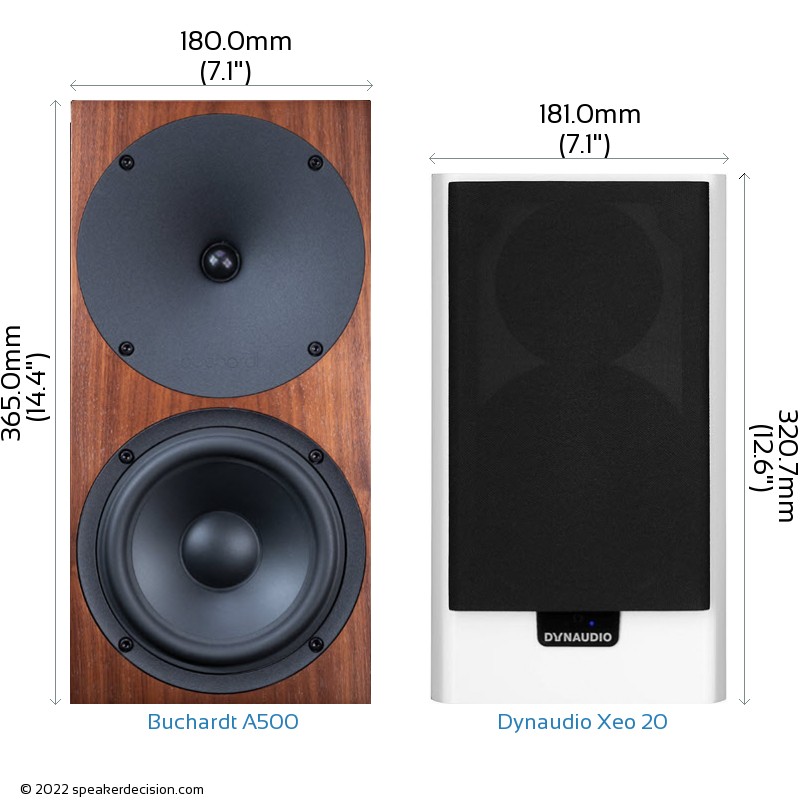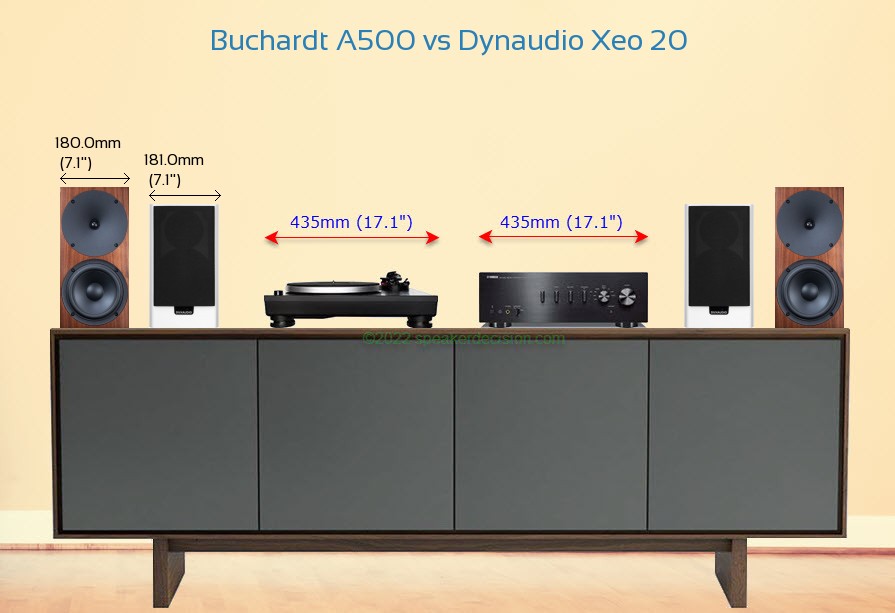In this review, we will be comparing A500 and Xeo 20, two Powered Bookshelf speakers from Buchardt and Dynaudio. Being Powered speakers, they both have built-in amplifiers so you don't need an external power amp or an integrated amp to power them.
Let's have a brief look at the main features
of Buchardt A500 and Dynaudio Xeo 20 first before getting into our more
detailed comparison.
Buchardt A500 Key Specs
- 3-way Design
- 450-watt RMS( 1320-watt Peak) Integrated Amplifier
- 0.74" aluminum waveguide Tweeter
- 6" Midrange
- 6" paper Woofer
- 25-40k Hz Frequency Response
- 24-bit Max Depth / 192kHZ Max Sample Rate
- Weight:9.00kg
- Dimensions (H x W x D): 365.0" x 7" x 11"( 365.0 x 180.0 x 280.0mm )
Dynaudio Xeo 20 Key Specs
- 2-way Design
- 260-watt RMS Integrated Amplifier
- 1.1" Soft-Dome Tweeter
- 5.5" Magnesium Silicate Polymer Woofer
- 40-21k Hz Frequency Response
- 24-bit Max Depth / 96 kHz Max Sample Rate
- Dimensions (H x W x D): 320.7" x 7.125" x 10.125"( 320.7 x 181.0 x 257.2mm )
In the following sections, we will get into more detail in order to better understand how the Buchardt A500 and Dynaudio Xeo 20 compare and hopefully end up with enough arguments to decide which one of these loudspeakers is the better choice for you.
**This post contains affiliate links, and I will be compensated if you make a purchase after clicking
through my links. As an Amazon Associate I earn from qualifying purchases.
Drivers
One of the fundamental differences between these two speakers is that A500 is a 3-way design whereas the Xeo 20 is a 2-way speaker. 3-way designs utilize a midrange driver in addition to the tweeter and woofer on 2-way designs. Designing a crossover for a 3-way speaker is a complicated process and generally increases the overall cost of the speaker.
| Driver |
Buchardt A500 |
Dynaudio Xeo 20 |
|
Driver Setup
|
3-way
|
2-way
|
|
Tweeter
|
0.74-inch
|
1.1-inch
|
|
Midrange
|
1 x 6-inch |
- |
|
Woofer
|
1 x 6-inch
|
1 x 5.5-inch
|
A500 features a 0.74" fine weave soft fabric textile aluminum waveguide Tweeter , a 6" Midrange and 1 x 6" paper Woofer with a Crossover frequency at 150Hz and 1800Hz. On the other hand, the Xeo 20 features a 1.1" Coated Silk Soft-Dome Tweeter and 1 x 5.5" Magnesium Silicate Polymer Woofer .
Frequency Response
A500 has a frequency range of 25-40k Hz whereas Xeo 20 has a frequency range of 40-21k Hz. With a minimum frequency of 25Hz, the A500 can go significantly deeper on the low side and provide stronger bass compared to the Xeo 20's min frequency of 40Hz.
Below graphs depict how these two speakers compare with the max, min and average values of the Min and Max Frequencies of other speakers in the Bookshelf class in our database.
Low Frequency
Bookshelf Speakers
High Frequency
Bookshelf Speakers
None of these speakers achieves full range experience which is commonly agreed as 20Hz-20kHz. In order to achieve lower lows / deeper bass, we recommend you pair these with a subwoofer. Visit our Powered Subwoofers section to find out more about the available options.
Physical Specs
Size of a speaker can sometimes become an important decision factor due to space constraints or in some cases purely for esthetic reasons. In this section, we are going to compare Buchardt A500's and Dynaudio Xeo 20's external dimensions. Buchardt A500 has external dimensions of 365.0 x 180.0 x 280.0mm ( 14.4 x 7 x 11inch) whereas Dynaudio Xeo 20 has external dimensions of 320.7 x 181.0 x 257.2mm ( 12.625 x 7.125 x 10.125inch) .
Dynaudio Xeo 20 is 44.3mm shorter and 22.8mm less deeper than Buchardt A500 but it is also 1mm wider.
Below you can see the front view size comparison of Buchardt A500 and Dynaudio Xeo 20 in scale.
 Comparison image of Buchardt A500 and Dynaudio Xeo 20 Size and External Dimensions
Comparison image of Buchardt A500 and Dynaudio Xeo 20 Size and External Dimensions
Base Surface Area Comparison
Base surface area of a loudspeaker may become a determining factor when the space in your room or desk is limited.
The base surface area of the Buchardt A500 is approximately 504.0cm2 / 78.1inch2 and base area of the Dynaudio Xeo 20 is approximately 465.5cm2 / 72.2inch2. The A500 requires 8% more surface area than the Xeo 20 which gives it a small disadvantage on placement in tight spaces.
Here is an another comparison that shows both speakers on a BDI Octave Media Cabinet, next to a standard size amplifier and turntable in scale:
 Size Comparison image of Buchardt A500 and Dynaudio Xeo 20 on a Media Console
Size Comparison image of Buchardt A500 and Dynaudio Xeo 20 on a Media Console
What's in the Box of Dynaudio Xeo 20?
Here are the items that come with the Xeo 20:
2 Powered bookshelf speakers2 GrillesTwo 8-feet AC power cordsRemote control2 AAA batteriesSetup Manual